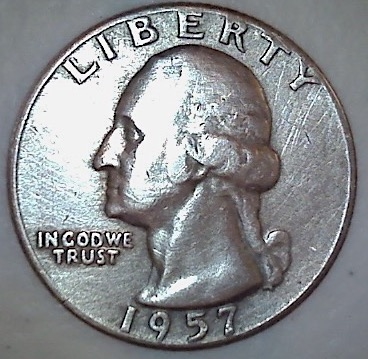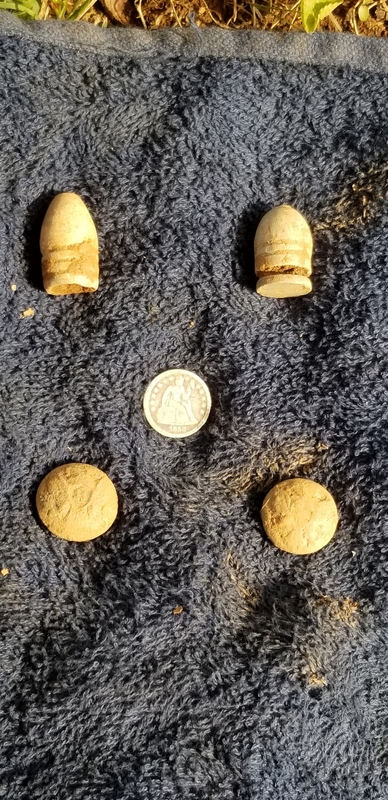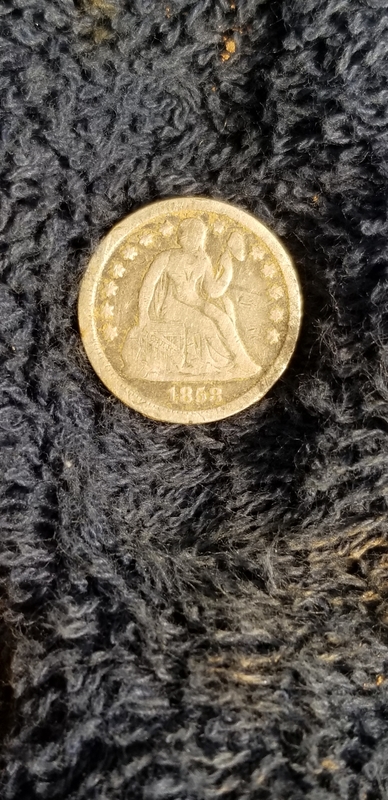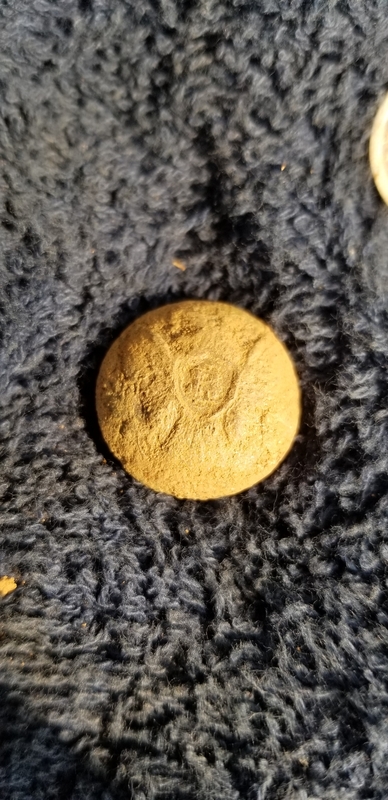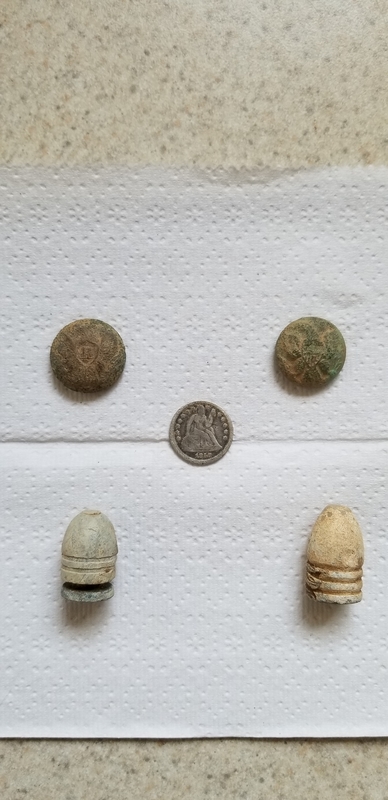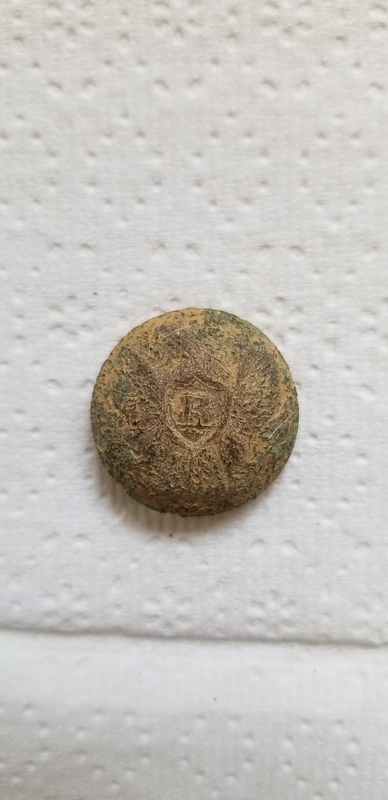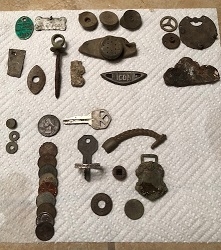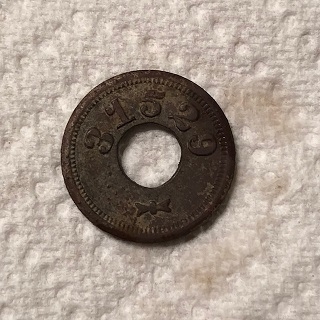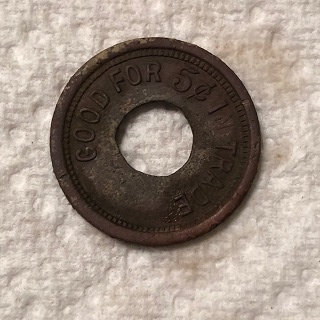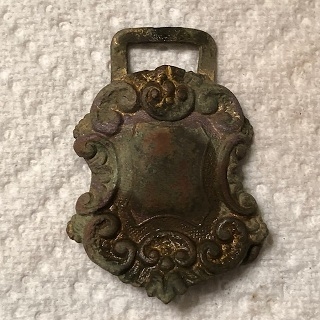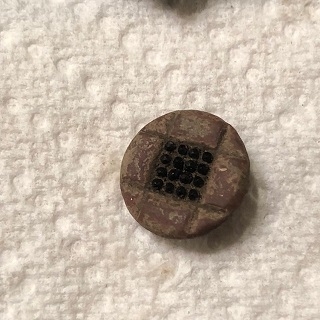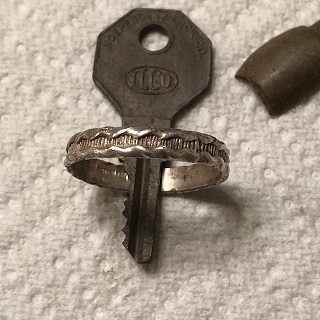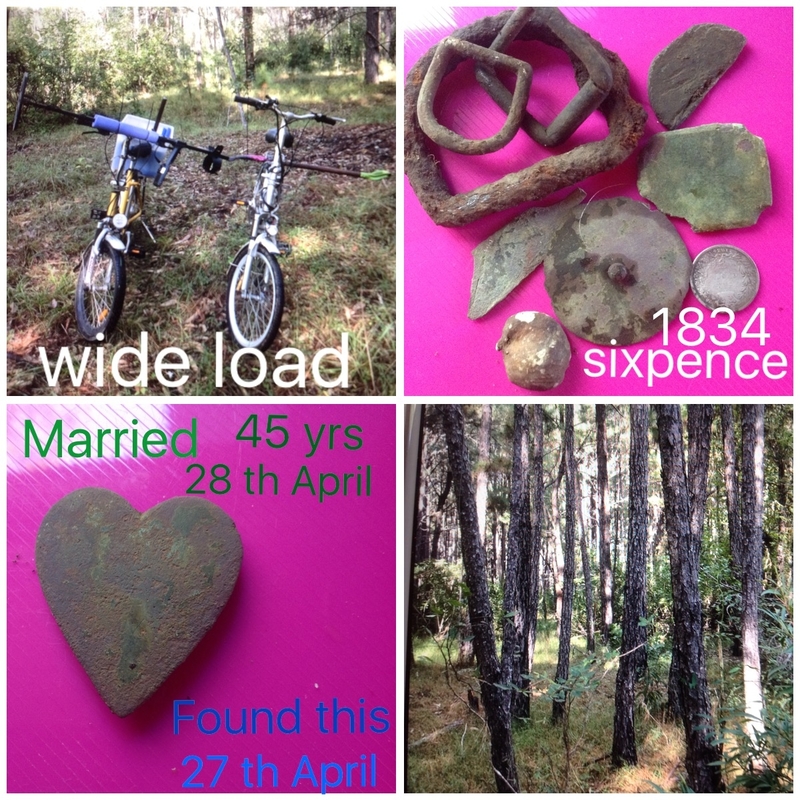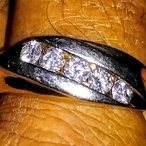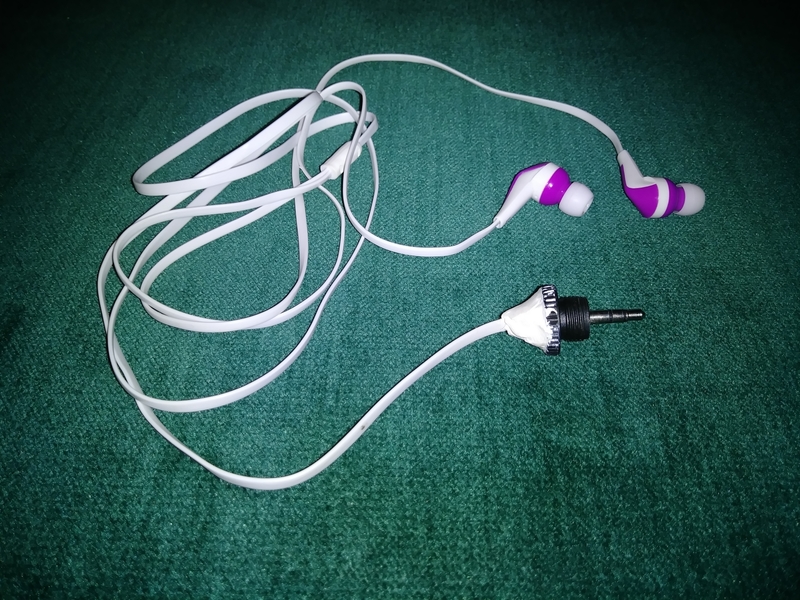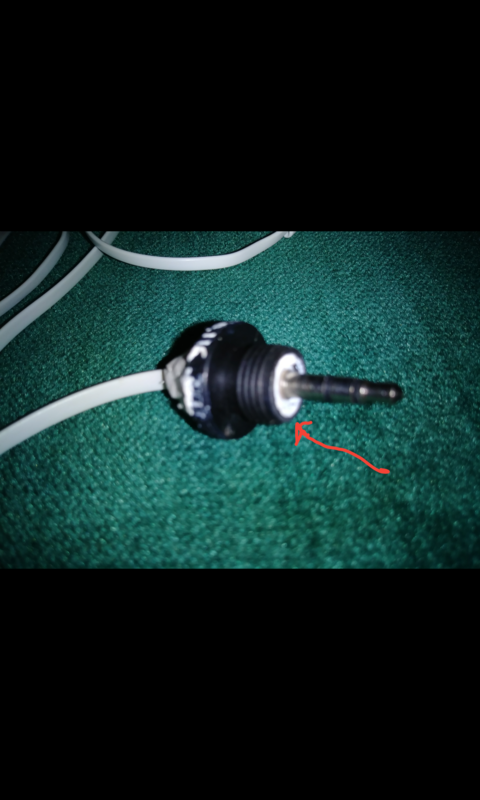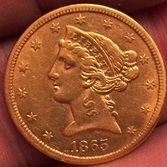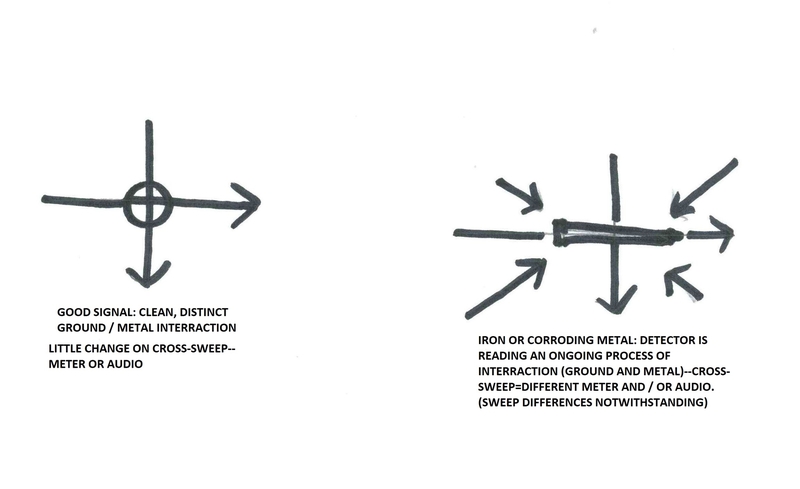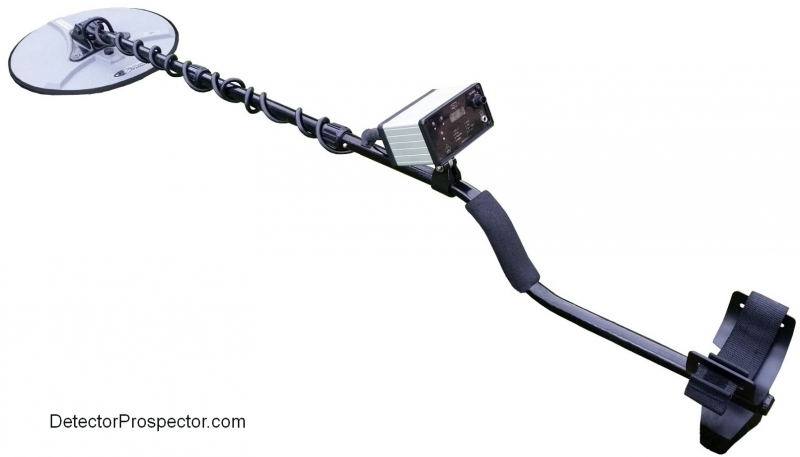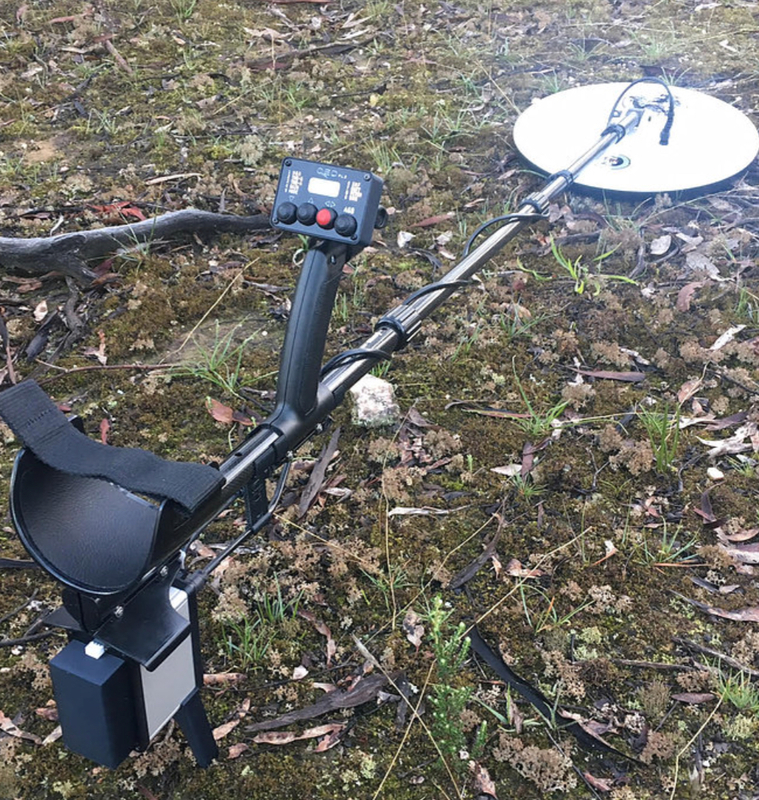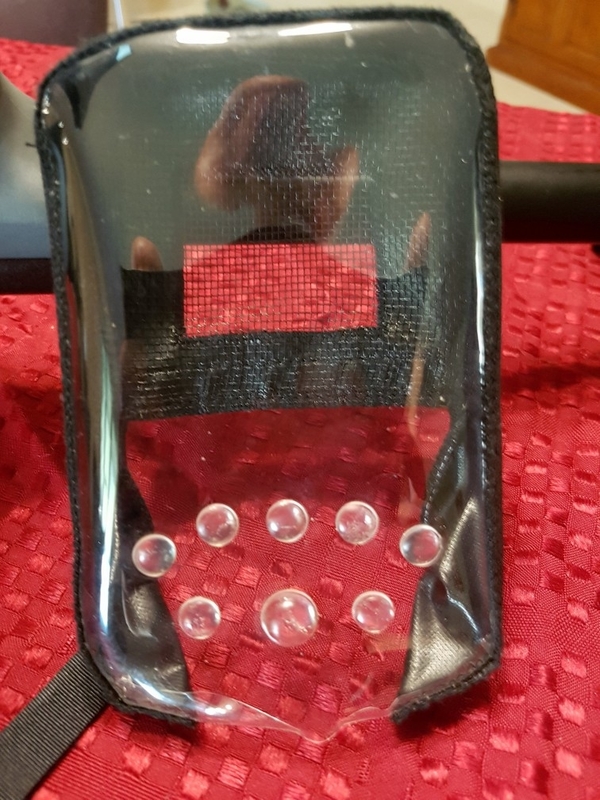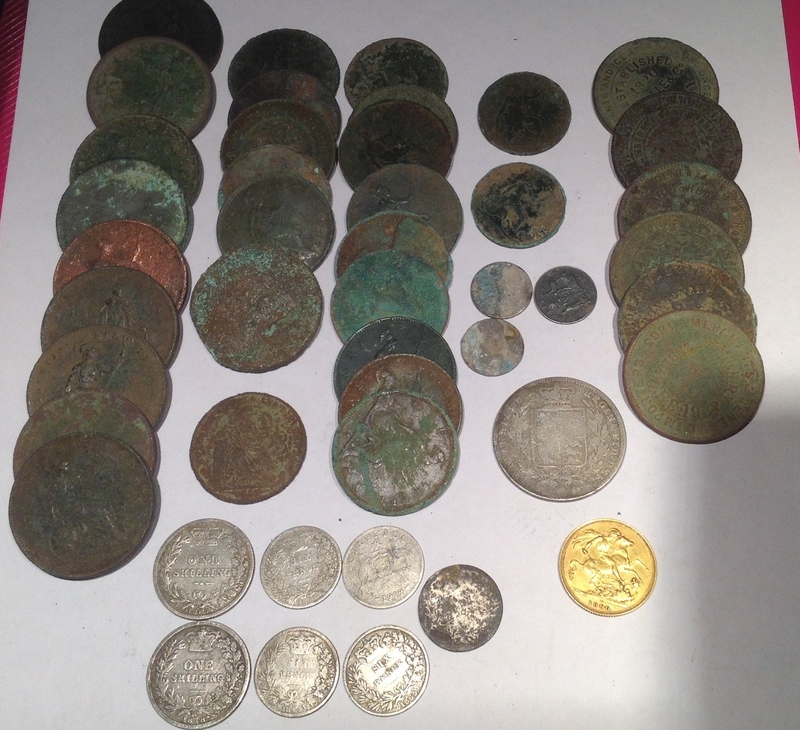Leaderboard
Popular Content
Showing content with the highest reputation on 04/28/2018 in all areas
-
So...started working the second block of demolished housing on base, but the pickings were slim on that block. Too much debris from the homes that were torn down. Worked it for about two hours, and got a severe headache, so I headed home to Ibuprofen, and some rest. Couldn't go back due to my son coming home from school in an hour, so I decided to just hunt a couple of the vacant homes right across the street while I looked out for his bus. Surprise! The two front yards yielded their hidden treasures. So many more homes to go and the demolished areas as well! Changed up a bit today. Went with the factory setting for Park2, and only switched to 5 tones while I still get used to the 600's quirks. Today's take: Copper Pennies: 19 Clad Dimes: 5 Clad Quarters: 4 Nickels: One 1961 Fishing Lure: Side Winder in great condition Find of the day: 1957 Silver Quarter....found in the median strip between the sidewalk and street. BIG surprise seeing that silver color in the plug! Tomorrow it's family hunt day with my wife and son learning their ACE 300's and me swingin' the Nox! Surprise find where least expected:9 points
-
I am loving my Equinox 800 relic machine (soon to be my Equinox beach machine and my Equinox water machine and also my Equinox park and gold machine). Hit the PA site I lovingly refer to as the relic hunter's amusement park which has been the site at which I have obtained several firsts and bucket listers including my first CW plate of any kind which I posted a few weeks ago. I have hunted it the last few times with the Equinox and it sets up well for that machine. For relic hunting, I generally favor Field 2 at the default settings. I have been experimenting also with Park 2. While the default settings for both are similar, there is definitely a difference in the underlying Multi IQ secret sauce based on the way the targets sound and also the way they hit the targets. I found Park 2 to hit a little bit harder on higher conductors, but this could just be my imagination. In this field, I like the Field 2 disc breakpoint at 2 because hot "rocks" in this field (from steam tractor coke tailings) come in at 1 consistently, and the Field 2 breakpoint is 2 vice 9 for Park 2. This is somewhat of a moot point because I generally run All Metal, but occasionally cut in disc when my brain needs a break and just listen for high tones. But the jury is still out as far as I'm concerned as to which of those modes I prefer most for relic hunting. I set up the machine to have the "main" program be Park 2, but with some Iron Bias cut in (3). I have Field 2 loaded up in the User Profile slot without modification from the defaults. In this manner I have a setup where I can quickly interrogate a target with or without iron bias with just a press of the User Profile button. Works great. I also cut in GB tracking for both modes in this hunt. The field has mild mineralizaation and Ground Phase variations typically seen in a plowed field with different crops and it worked well. Well, Equinox delivered once again. Scored a beautiful 1858 Seated Dime (she turns 160 this year, no wonder she is sitting down) and my first Rifleman's Eagle Button ("Eagle R"). Rounded out the hunt with a minie ball, a Williams Type III "cleaner" minie ball (my first Type III), and another Eagle button. Not shown are a 1936 Wheatie and various tiny non-ferrous odds and ends including lead, brass, and copper fragments. Pulled some large ferrous objects too as I had the time to chase some iffy signals and did so. Large, flat iron rings high and forces me to investigate, but in all metal, you can hear the iron grunt too and know you are likely digging some iron and not a masked keeper. But if you have the time...dig 'em because you never know... The site really helps, I have had success here with the Deus as well, but no doubt the Equinox can, will, and has delivered the goods and I gain more confidence with it in every successive outing. HH9 points
-
Phrunt, the developments I have mentioned in regard to the QED have been mainly cosmetic, with improvements to the battery compartment, exterior wiring, and the stem and handle. A couple of improvements have also been made to the functions, the model that Steve has been kind enough to show is the current model, with the Detech carbon fiber collapsible handle and stem. When first introduced in early 2017 the QED was available in a DIY format where you could purchase just the control box and add your own choice of battery, stem and handle, and coil. The QED will operate with any Minelab or aftermarket (Coiltek, Nuggetfinder etc) PI coil, giving you a great range to choose from, and operates well on all sizes provided they are mono. If you use a DD it will operate only on one D. Electronic updates have been provided free, with a charge only for freight. The control box is quite small and light, and is all that is required for updates, with turnaround times being very fast. The QED has auto ground balance, but not auto ground tracking. It is a manual GB machine, but in saying this it is quite forgiving, requiring only occasional re ground balancing. It does not have discrimination, and is primarily a gold hunting machine, although recently tested on a beach in Nha Trang, Vietnam where it performed really well. Howard has added a beach function in the current model, and you can detect from dry to wet sand with no problem, and no change in performance. Several coins were found in only a short time of testing. I hope this has been informative, and that the QED will soon be available to gold hunters in the USA. In closing I would just like to state that I have no financial interest in the QED, but would like to see it get the recognition that it and its inventor deserve. Cheers, Reg.8 points
-
Took the Nox out for a door knock adventure yesterday. I was cruising the historic section of town and parked in front of an old Victorian house. I decided to do the curb strip to see what kind of reception I might get. About two minutes in I hit a sweet sounding 31/32 signal and out popped the silver ring. I continue to hunt and as I'm hunting I hear loud music coming from the house. Turns out it's a few young guys practicing in their garage! When they took a break I went up and asked if I could detect their property. No problem. So, not only did I get to detect but I got to listen to some damn good music as well. If I stood down wind of the garage and inhaled deeply...well, it reminded me of my first Pink Floyd concert! What I remember of it. Anyway, I came away with a few goodies and was invited back. Cool token, suspenders buckle, button, and ring. Wheaties but no silver coinage...yet. Gonna go back soon. Park 2, Sens 20, 50 tones, Iron bias 1, response 6, factory disc or AM depending on my mood. Dean5 points
-
4 points
-
Thanks, everyone. Sharing the adventure is half the fun and what I am really blessed with is some great detecting friends who let me tag along to their permissions. Even public tot lot detecting is verboten in my community, with posted signage my tax dollars paid for. I am actually paying my local government to not allow me to detect. Lol. But enough with "Don't Tread on Me" themed rants. What I really wanted to say is that I forgot to provide some target ID info. These were the first CW military buttons I snagged with the Equinox. Minie Balls ring up around 17 give or take and the buttons ring up around 15 give or take. HTH3 points
-
At the recent Minelab Americas annual Partners Conference, there was a Q & A session with Minelab engineer Mark Lawrie and Peter Charlesworth, President and CEO of Minelab. I put to them the question of when we could expect discrimination on the GPZ 7000, and their response was that discrimination is NOT possible with the ZVT technology. Needless to say, quite a letdown.? On the bright side however, they did say that there will be 2 more software updates for the GPZ 7000, but did not give any details on what they might be.3 points
-
I made a waterproof connector using the cover plug for the WM - 8 module... using my Dremel I carefully cut a hole in the top and had to slightly widen the two ribs that come down inside the plug... becareful not to mar the edge of the plug where it seats against the O-ring ( red arrow) clean it all up with acetone or denatured alcohol... then use 3M 4000 sealant it's good for plastic! You can find it in any Marine store! I first screwed the plug in to the head of the machine then I coated the plastic of the 1/8 in headphone jack and inserted that through the hole I made making sure it plugs all the way into the machine if you're not sure turn it on and check! I then added the glob to the end to make sure it's sealed! Remember everybody you're at your own risk when you make anything for your machine! I have about ten hours on it!2 points
-
Great hunt! The next time I'm relic hunting and get some iffy signals, I need to check it in other search modes. So far I've mainly been using Field2, only because it works so well, but it's time to test out some other modes when I get one of those hmmmmm targets. HH, Brian2 points
-
I would not expect any other answer - the last guy who mentioned what’s in the lab no longer works at Minelab! All you need for discrimination is phase information, and the GPZ as a continuous wave detector should be perfectly capable of collecting and processing that information. I could of course just be wrong about that!2 points
-
I managed to get some time to do my 5th beach hunt with the Equinox. I was a bit anxious (self-imposed lol) about continuing my gold streak. I had a plan of attack and was optimistic about this hunt. But I did miscalculate the tides and it was evident when I got to the beach that my plans would have to be altered. I got the low tide correct but never considered how the wave action would not allow me to hunt comfortably at low tide. I struggled the whole hunt and finally conceded defeat ---- I would not get gold on this hunt ☹ My steak would be over, and I could finally get back to normal hunting. I got to the beach around 7AM and it was nearly 4PM and I was just wandering around basically just trying to coin hunt. On this beach there are some types of black rocks that read good to the machine, and on the Equinox, they read in the range of small gold. You must dig them. This next signal was similar to the rocks, as it was an iffy reading, and was in the TID range. I got the signal out of the sand and started spreading the pile out with my coil. Suddenly on one sweep, I removed enough sand to see this shining gold cross appear. I could not believe my eyes (and luck) ….. My gold streak would continue! I did manage to get some silver on the hunt, and also found a lot of remnants of coins. Coins in this area disintegrate to tiny bits of metal. I’m looking forward to next week’s hunt #6. I’m getting anxious already ?.2 points
-
A machine with the sophistication of the Equinox is much more readily able to identify iron by how it responds on the cross-sweep. This is because iron is more like the ground than a non-ferrous target. You could say that it is fully “grounded.” Many larger iron objects will sound off well from the standpoint of the first target sweep but when you check them on the cross sweep they lack consistency. In effect the detector is reading an interaction between ground and metal--rather than just metal. This interaction is not stable or “complete” in the same way as a solid, consistent target like a coin or ring. You could say that the detector is reading a changing “process.” With a high gain detector like the Equinox, understanding this one simple bit of theory will save a lot of digging. Another basic method to get a better idea if a signal is iron is to simply compare how loud it is with the depth meter reading. A blaring response that reads full depth is probably something larger than a coin or ring. As well, where you see a response that seems to change location or needs to be “coaxed” to give a response--suspect iron. In that some of the Equinox’s more complex iron muting features (Iron bias) can reduce depth, having a good command of these inherent, checkable differences between an iron signal and a non-ferrous one can help your accuracy a lot. Picture Caption: Basic signal quality differences: ferrous (L) versus non-ferrous (R). This is how the well-known bottle cap ”tell” method of removing the coil to produce a low tone works. Whereas a good target is either heard or not, a cap has a surrounding field that produces a low tone. From: “The Minelab Equinox: From Beginner to Advanced” By Clive James Clynick2 points
-
Just beautiful old rare coins there Congratulations Judy A gold sovereign coin is on every Aussie detectorists bucket list2 points
-
A pinpointing exercise I learned involved taping coins to irregularly sized flat pieces of cardboard. Flip the cardboard onto the ground (coin side down) then attempt to PP the coins. You can even go so far as poking holes through the cardboard with a pen or golf tee at the point where you think the coin might be to see how close you are. Great way to practice and compare different pinpointing techniques without the underlying bias that results from seeing the object you are pinpointing while you are pinpointing it. Not sure, but I think the coils on the Go Find series detectors are square coaxial, which is inherently easier to pinpoint with than a DD coil since the target pinpoints in the center of the coil vs. along the vertical center spine of a DD coil which represents the active region of the DD coil. Can't explain the degradation in your pinpointing techniques but suggest the above exercise to get your PP mojo back.2 points
-
Thanks! Clad coins do not hold up in certain areas of the beach...maybe if I tumble them they will look better2 points
-
Hope if he is he realises there is more valuable treasure over in the UK than here in OZ .2 points
-
LOL Judy. Or maybe Bruce Candy HAD it in his head, and then put it into practice, and he's busy cleaning out the parks and beaches with it! ;) Steve2 points
-
QED Metal Detector Website QED Detech Complete Package Here are a few existing QED threads... http://www.detectorprospector.com/forum/topic/2690-finally-the-qed-arrives/ http://www.detectorprospector.com/forum/topic/3099-qed/ http://www.detectorprospector.com/forum/topic/3022-qed-review/ http://www.detectorprospector.com/forum/topic/3839-qed-field-test-report/2 points
-
Awe how sweet is that . Thanks I will always remember that2 points
-
Walter - First of all, hang in there. It is going to be a frustrating journey because you are being forced out of your 14-year XLT comfort zone. It is not going to be love at first sight. You apparently picked a tough site situation and without experience on the machine did not have enough familiarity with the machine to be able to tweak it to compensate for a tough situation (sprinkler pipe and few targets). The XLT and the Equinox are very different in their speed and range of target sensitivity so you can easily get overloaded by what the Equinox is telling you. I was coming from a Deus which is similar to Equinox in terms of speed and tonality (i.e., target dig decisions are based primarily off tonal cues rather than off visual target IDs), yet still am climbing somewhat of a learning curve. So despite your years of detecting experience, there will be some getting used to a different beast and that may take a few outings to get both your comfort level with the machine up and your confidence in the machine up. This will come with time and certain things will click. Couple of friendly suggestions. First - see if you can track down Steve H. and follow behind him. Lol. But seriously, grab some popcorn and try the following: Site Selection - Try taking the machine to a site you are familiar with, that produced at one point and preferably is still producing. Do not challenge the machine or yourself the first few times out. If you have no choice but to go to a hunted out spot, at least try to find a site that is free of other issues like plentiful ferrous and non-ferrous trash, nearby interference (power lines), and other similar difficulties that are normally fun to overcome when you are on top of your game but that you don't need to deal with when learning a new machine. Since you are not familiar with the machine, at least go to site you know like the back of your hand. Mode Selection - Pick the mode appropriate for the site and stick with that mode regardless of the results. By appropriate for the site I mean appropriate for the targets you want to find and that you are most likely to find at that site, not just the landscape. If you are coin shooting - go with Park 1 or Field 1 as those are geared towards hitting harder on high conductive targets. If you are going after primarily mid-conductive targets (gold, brass or lead relics, small jewelry, nickels) then you can go with Park 2 or Field 2 which are geared towards those targets. Note, however, the "2" modes are hotter and will hit hard on aluminum trash and small trashy objects which can be overwhelming. That is why I recommend Park 1 or the oft ignored Field 1 (because it is a two-tone ferrous/non ferrous beep mode) as the best "training ground" modes for newcomers to the Equinox and to fast detectors in general. Beach modes are also great learning modes (esp. Beach 1) if you are at a salt beach, especially. But since this is likely not the case in Reno. I would stick with Park or Field 1. Don't bother with Gold modes for now because they are a different animal with respect to tones (VCO-based) and you only need to learn one detector at this point. I am not kidding by the way about learning one detector. Each of the modes behave so differently, it is literally like you are taking out a different detector every time you switch modes. Folks have advised to not over tweak the settings. But I am advising you to not over select the modes. Pick a mode and stick with it. Learn it. Love it. It is a multifrequency machine after all, so even if you stick with one mode you will not be stuck finding only one type of target. So don't be afraid to use your "go to" mode at multiple different sites even if you are looking for different target types. Once you gain confidence, feel free to shift around and learn what the other modes can do. But if you shift modes every half hour out of frustration, it will be like running to grab a new machine every half hour. So avoid the temptation to do "Mode Hopping". Settings - Once you have settled on a mode. Your goal is to set your machine up to run as quiet as possible. Do NOT get into a reactive mode and start tweaking settings because you are not hitting targets. Adjust settings, if necessary, because the noise is keeping you from hearing the targets. Equinox is set up for success when you have maximized signal to noise ratio not when you have maximized signal gain. Here is what you do - Auto Noise Cancel - keep the coil in the air when you do this. If you have relatively mild soil - you do not have to ground balance because the machine is pretty forgiving if GB is not set precisely to match the actual ground phase, but I go ahead and do an auto GB (hold the accept/reject button and pump) regardless and let the machine zero in on the right GB reading, especially if I know the soil has some mineralization. Do not adjust recovery speed or Iron Bias from their defaults. Once you come out of the settings menu if the machine is still chatty, then dial down sensitivity as necessary to get rid of the chattiness. Don't be afraid to go low because the machine is pretty sensitive at the default and will still go deep - you need it to quiet down, though. Take Steve's advice. Once you think you have the machine running quiet then start swinging. If you are using a mode that uses 50-tones (Park 2, Field 2), you might want to adjust that mode back to 5-tones to keep from getting overloaded. The "1" modes default to 5 tones (Park 1) or 2 Tones (Field 1) which makes them a good starting point. 50 tones really gives you a feel for tonal nuances on targets so you may eventually want to go there but if you find it overwhelming, no problem just going with 5 tones or even 2 tones. Swing technique and Target ID - Use your test garden to gage the best swing speed for the recovery speed setting you are using. This may take a little getting used to. The faster recovery speed of the Equinox will tend to force you to swing perhaps a little faster than you are used to in order to get a good target signal response. You can, of course, overswing and also not get a good response but you should practice and listen to what good targets sound like and get to the point that you can just wiggle the center of the coil over them to get the response you need. Listen to the good tones and bad tones. Dig probable junk to verify your suspicions. This will build your aural muscle memory and get you use to the tones. Rely on target ID to back up your tonal ID and look for target ID bounce indicating likely junk. Also, make liberal use of the All Metal Horseshoe button to interrogate a target and listen for iron tones which may indicate that the tone you are hearing is iron falsing. Now I will say the depth meter has been reported to be a little wonky - I don't use a depth meter anyway so I am not missing it on this machine, but there does seem to be a love-hate relationship with it amongst Equinox users and the pinpointing feature is also a little quirky, but I have gotten used to it and like it not because it helps me pinpoint the target better (I use the wiggle off method primarily) but because it is a non-motion mode that gives you some good audible information on the target to help determine relative size and depth. As you gain confidence in your abilities with the Equinox you can start tweaking other settings, but don't do it without a purpose (remember - the key is getting rid of unnecessary noise or falsing, but it is always a balancing act against losing target depth or inadvertently missing a target due to overfiltering - e.g., overuse of iron bias). The default settings are good for 80 to 90% of your detecting situations. Also, you may gain some insight based on what you wrote above. In one post you said you went through all the modes, you tweaked recovery speed and iron bias, you dialed down on sensitivity. In the next post you said all you did was switch modes and left the settings at their defaults. So there may be a little new machine confusion going on. To ensure you are starting at the default settings for your next outing, you may want to take Bill's advice and do a factory reset. Again, Walter, hang in there and stick with the machine for awhile. It will grow on you after a bit, you just need to snag a few keepers to gain confidence in the machine. Once you get on a roll, you will steadily climb that learning curve. But the best thing you can do is minimize the variables that force you to take backward steps. Good Luck and Happy Hunting, sir.2 points
-
Discrimination on the GPZ has little to do with prospecting and everything to do with the next generation of coin, relic, and jewelry machines. As far as prospecting goes, discrimination is an option you can use or not as you desire, if you detector includes the capability. If two nugget detectors find gold equally well, but one offers ferrous discrimination capability, I will always go with the machine that offers more capability myself. Digging everything sounds really nice until you face a situation with one thousand nails, four gold nuggets, and two hours to sort them out.2 points
-
LOL! I don't think there is ANYTHING wrong with the ergonomics! This detector is a PLEASURE after having swung a GTI 2500 for a number of years. Like a feather, and easier to maneuver. Some people just can't be pleased....2 points
-
This is the Ultimate Minelab Equinox 600/800 VDI Numbers and Tones video covering Rings and other Jewelry. I cover Platinum, Gold, Silver, Tungsten, Stainless Steel, and Aluminum Rings. Pendants, Earrings, and even go over various different style Pull Tabs. A lot of time was put into this labor of love Test/Demonstration video and hope it helps out new Equinox users. Make sure to also check out my video covering Coins. GL & HH1 point
-
Tried out a new detector on Saturday:Due to some unavoidable delays, I finally made it out with my Makro Gold Racer on the weekend to see what it could do.I don't know about where you live, but winter here just didn't want to let go this year. I mean, we had one of the coldest, longest winters we've had in forever, and snow, snow, snow (we're about four feet over the average mountain snowpack at the higher elevations as I write), but Old Man Winter finally took a breather, and so I got a chance to head to the mountains to swing the coil again.The place I picked was one that didn't have a lot of exposed bedrock, just a small section really, with the rest of the ground covered with six to eight feet of overburden on top of the bedrock, and that's just too much overburden for the size of gold I commonly find.As for the weather that day, it was a true mixed bag. I mean this time of year, we can get all four seasons in one day! Saturday was no exception. It rained early in the morning, then the sun came out and it was nice and warm, then it clouded over, started to rain again, then turned to snow, then the wind blew a cold blast of air for about an hour, then the sky turned blue and the sun came out once more, the wind stopped, and the weather did its best spring imitation for the next three hours.I unlimbered the Gold Bug Pro first, and you can't make this stuff up, within three minutes, I'd found a three gram nugget, one my wife said looked sort of like a four-leaf clover. And, Nature indeed had made it look kind of like one. The nugget was sitting in some tough clay that held a lot of former river stones, so it seemed to me that it was likely what used to be the bottom of a crevice long ago, as the surrounding bedrock had been cut down at least a couple of feet by the former placer miners whose actions would have left the sort of deposit I've described.I kept working the exposed bedrock and any places I could find where bedrock had been tossed out in case some gold had ridden out with it. (I have found nuggets this way before.) I really took my time and went slow, because I wanted to be sure I'd cleaned the area before I broke out the Gold Racer so I'd have as accurate a comparison as I could. By the time I'd finished with the Fisher, I'd gathered another gram and a half of small stuff that I'd thrown in the bottle.My wife had wandered off, and I found her panning near the foot of channel wall, but she wasn't having much luck; however, she pointed out something to me that I'd have completely missed. To the north and east of where she'd been panning, there was a short section left of what had been a bedrock drain, and there were small sections of bedrock still exposed that the boulder clay hadn't reclaimed.Nevertheless, I headed back to the original bedrock I'd worked with the Gold Bug Pro, and I broke out the shiny new Makro Gold Racer. The ground balance worked flawlessly, and setting the sensitivity was a breeze. The ground was moderate to a little hot, so I didn't have to worry about adjusting the ISAT, and I was pretty familiar with the types of hot-rocks I'd likely find, so I knew most, if not all, of them by sight. I started by running the coil slowly over the areas I'd hit with the Bug Pro, and after a few sweeps, I had several quiet but distinct signals. When I dug down, the signals got louder. I called by wife over, and she took the dirt with the signals and panned them out. Neither one of us could believe the tiny gold in the pan! The Gold Racer really did deliver on finding small gold. However, the first bedrock area was not where I realized how good the Gold Racer could perform.Remember I mentioned the bedrock drain? I headed over to it with both detectors. First, I scanned the small exposed areas exceptionally carefully with the Bug Pro, and I got a few small pieces, then I ramped up the sensitivity on the machine as far as I could, fought the background chatter, and all in all, liberated about half a gram of gold from the bedrock. I swapped out the Bug Pro for the Gold Racer and covered the same areas again. Almost immediately I had a signal. I couldn't believe it, but the signal was clear, and I could see a previous dig mark where I'd nailed some small stuff with the Bug Pro, and the Racer was giving a crisp signal, quite unmistakable, right in the same dig hole! To make a long story short, three inches of bedrock later, a nice picker was in the bottle! This blew me away, as the Gold Racer had found the target while running nice and quiet, with the sensitivity not ramped up, yet the signal was very clear.I kept at the small sections of bedrock, and kept getting quiet, but clear, signals until I'd added another gram and a half of small gold to the vial. (Sometimes I'd get a break in the threshold too, but when I dug down, the signal either disappeared or it turned out to be a target. [Some heavy iron deposits in the bedrock did give a weak signal, but I soon learned that due to the broad nature of their signature exactly what they were.]) What this weekend's outing made me realize is that if I'd have given the Gold Racer a run the end of last summer, I'd have undoubtedly recovered a lot of small gold, and I do mean a lot, that the Bug Pro just couldn't see (this test was carried out with virtually the same coil sizes on both machines, elliptical shapes and DD's as well), and knowing now what I likely left behind last summer makes me a bit sad. (Out of six grams of gold for the Saturday, a gram and a half was fine stuff from the Gold Racer, and that's a pretty good added portion of gold recovery I'd say.) In fairness to the Gold Bug Pro, let me say this: I've found lots and lots of gold with that great little machine, and it's super easy to learn how to use making for a quick learning curve. In addition, I don't have an unkind word to say about the Fisher as it's paid for itself many, many times over, and I will continue to use it, and I'll continue to train others how to use it as well. Moreover, let me say that the Bug Pro doesn't run at nearly as high a kHz, so it's unfair to compare apples to oranges that way, but I wanted to see what I was leaving behind, that's all. So, I learned my lesson well on Saturday, and I gained a whole lot of respect for the little Gold Racer for how sensitive it is to small gold, how good it punches into the ground to find it, and how quietly it goes about its job of doing so. Furthermore, The Makro is a great little gold machine I can swing all day long, and I'm looking forward to really taking it for a long, dedicated run this summer to add more gold to the poke because it sure gets the job done in style! (How I wish some fine company would produce a light-weight gold-hungry pulse machine with excellent capabilities or that Minelab would find a way to lighten the technology package of their GPZ 7000. Wouldn't that be great?) (I'd like to thank Steve for pointing me in the direction of the Gold Racer, and I'd like to thank Dilek at Makro for her exceptional customer service.)All the best,Lanny1 point
-
1 point
-
1 point
-
Steve, I'm not taking you up on the challenge but I will give a 'comparison' that could make any detector 'lighter' and more manageable. I used an SE Pro for a few years before I bought a CTX. I had no problems with it and the CTX while using the standard coil. When I bought a 17 inch coil for the CTX I developed 'tennis elbow' after just a few uses. I had to stop for a few days. When I started back I used my hipstick for my 5000 and I could adjust the CTX 17" coil to weightless! An added feature of this is that when you dig a hole the detector hangs there (sometimes in the way) but a wave at the beach is not going to grab it. I have a bungee on it already. I have not used my CTX since the arrival of the Nox. It is still with me tho that I would like to take the hipstick and set up a lighter bungee and balance it to weightless. No matter how light the Nox nothing beats an adjustable bungee for swinging long sweeps or short ones. The Nox is usable for most of the day without stress or pain but a bungee COULD make it better. Mitchel1 point
-
Elf -- SUPERB! Another "on base" surprise for you! Plus a bunch of more modern coinage, that is going a long way toward helping you to learn the machine. You are doing great! And that "family outing" sounds like it would be LOTS of fun!! Congrats! Steve1 point
-
Ha! That's for sure. I did recover a fairly recent pocket knife drop in their yard. They said that it wasn't theirs and that I should keep it. I gave it to one of the guys. The ring is huge and, I think, fairly old. It is too large for my thumb! Must have been a BIG person's ring. Dean1 point
-
1 point
-
Great hunt, that ring has a cool design. Sure doesn't look like the garage band lost any of that stuff, lol.1 point
-
Thanks guys! It was a fun hunt. It reminded me of long ago...no responsibility, no worries, and...no money. Responsibility pays better. Dean1 point
-
Love those old watch fobs...ill have to try the hunting down wind thing myself sometime...theres lots of that pink floyd stuff going on in the parks i hunt...digging pull tabs might actually become enjoyable lol strick1 point
-
My battery lasts right at 12 hours. My headphones last longer about 20 hours I am guessing but since I have had both the detector and headphones go dead while detecting I always recharge when I am down to the last bar and recharge the head phones at the same time.. Headphones seem to always recharge quickly I usually detect 2 - 3 hours so I usually always recharge about every 4 days and sometimes sooner Going to try the beach again on Monday1 point
-
That's awesome! I haven't tied the door knock scene (yet), but Pink Floyd, oh hell yeah1 point
-
1 point
-
Same here . I think Bruce Candy has it in his head and just not ready to give it to us . Maybe our grandkids . ?? Hope gold won't be worthless by the time it happens1 point
-
Just assembled my 800 and both upper and lower cam locks leave shaft rotation even when fully tightened. I have wrapped several layers of polyprop tape around the shafts and now there is zero rotation. What are Minelab doing to effect a permanent fix?1 point
-
SUPERB ring!!!!! You say you are going to "have fun digging those 14s and 15s?" UGH! That sounds like "rusty forks in the eyeballs, bamboo shoots under the fingernails" to me, in the parks I hunt! If I did that, I'd literally fill 5-gallon buckets with rectangular tabs... YUCK!!! Somehow, some way, SOMEONE has GOT to be able to develop a way to indicate that while a Coke can tab, and that gold ring you found, might read exactly the same from a VDI and audio perspective, there is a TREMENDOUS density difference there, between the two objects. I know metal detectors using current technology would have no way of sensing or determining density directly (but instead make ID assignments based on size of object and "eddy current flow,") but SOMEHOW, it HAS to be possible to dream up a method where the differences in density/mass between aluminum and gold could be somehow exploited (while still in the ground)... For instance, I have to believe that there's a way, using some yet-to-be-identified number of different electromagnetic transmissions (maybe 5, or 10, or 15 of them, at various different frequencies), to sample gold rings versus rectangular tabs in a lab, and using the characteristics of the return signal emanating from the two objects from each of the different transmit signals, to identify some differences (using statistical techniques) that could result in at least a REASONABLY effective "gold versus aluminum" discriminator... Steve1 point
-
NICE!!! While your gold cross is BEAUTIFUL, and you have some great silver coin success, you have some U-G-L-Y clad coins in that pile! LOL!!! Congrats on success despite the conditions! Steve1 point
-
1 point
-
Good point I had forgotten - thanks Nenad. The Gold Racer Pro Pack with two coils etc. runs US$799. That would tend to make it seem the Gold Racers days are numbered. I have not seen anything about a larger coil for the Gold Kruzer. I like that coil, but there may not be much actual demand for it. Still, I see they have the big coil out for the Multi Kruzer.1 point
-
Awesome find Judy! Happy 45th Anniversary! Here is a rendition of Little Wing by Larry Hutcherson to enjoy on your anniversary.1 point
-
1 point
-
Anyway, back to the 56 kHz Gold Racer. At US$599 it compares well to other detectors running at 30 kHz or higher. However, the big question is whether it will continue to be manufactured or whether the soon to be released 61 kHz Makro Gold Kruzer will replace it. The Gold Kruzer is waterproof and offers a three tone mode versus the two tone modes available on the Gold Racer. That does make it better suited for hunting for micro jewelry. However, it also runs $749 and I am not sure that it will find nuggets any better than a Gold Racer. The 5 kHz difference is not enough anyone would see any difference in the field due strictly to the slightly higher frequency.1 point
-
That is Lockey---he kills it with the Monster.... he had 40 pieces the day before yesterday--small but they all add up.1 point
-
I'm on Jerry's waiting list. I contacted him last week and he thought it would be 30 to 40 days. He emailed me right back and was very honest in that he did not want a deposit. My local dealer (robber) in these parts wanted the entire $900. I have not purchased a brand new machine in 15 years, so I'm very excited! This time of year is the best for me in these parts as woods metal detecting goes....as is the fall. Mind you, all the silver I've seen coming out of the parks in youtube I might have to become a park hunter Very happy to have found Gerry...I've had issues with the Muppet's at Kellyco as well! HH Sillllvar1 point
-
Listen to "Steve Herschbeck" on Spreaker. but it is Steve Herschbach1 point
-
Hi lutfi. In mild soils you get the ability to use the GPZ in Normal gold modes which means tapping into the full depth potential of ZVT. In Normal operators will notice more sensitivity to the Ferrite ring In Normal there will be more ground noise In Normal the Ferrite balance is a lot more important especially if the soils have varying degrees of X signal (Ferrite like material) In Normal the Ground balance will move around a lot more, so an operator needs to be aware that rapidly lifting or tilting the coil or poor coil control can cause the GB to drift out of optimum, so they need to maintain the GB more by checking its accuracy more often (pump the coil without the Quick-Trak button to bring the GB back into line with the local ground conditions) Settings for Normal using GPZ 19, GPZ 14 with a B&Z booster and dual speakers: I use very similar settings across the board on the GPZ, so long as the Audio Smoothing is OFF so I can tap into the full low noise floor potential of the GPZ 7000. Sensitivity 7 to 9 (usually 9) Audio Smoothing OFF Volume 8 or even less if the ground is variable Volume Limit 8 to 10 or even less than 8 in variable soils Threshold 27 Ground Balance Auto Tone 60 GPS OFF (important little snippet that one which requires a thread all on its own) Ferrite Balance notes: I always use the Ferrite ring and I check the Ferrite balance often. Initially at start up and then again 30 minutes later and often after that just to be sure. You need to calibrate to the Ferrite for each Gold Mode and Ground Type Mode you are using, the Ferrite balance will move around more in Normal Modes so I check it often. If there is no X signal in the soils you are working then you won't hear the X signal if the X balance is out, however in my experience all gold bearing soils have X signal so it pays to keep a good X balance regardless of the soils being worked. If there is X signal present and the Ferrite Balance is out then the X signal can mask target signals without your even being aware, plus if the X balance is out it does have an effect on the G balance behavior because the two are symbiotic. G balance is the regular ground balance of PI machines, X is the Ferrite balance, due to ZVT the GPZ is susceptible to X so the ground balance software has to combine the two, they interact with each other. Difficult and Normal: Difficult removes ground signal but also the null points of the modes (High Yield, General and Xtra Deep) are different to each other across the Ground Type modes (Difficult compared to Normal). For instance a 1/2 ounce solid nugget will give a better response in General Difficult than in General Normal, this is not due to ground signal but more to do with the modes sensitivity points. Some nuggets will fall into a modes least sensitive position that's why it pays to go over ground with a variety of modes. In Australia we often only have the choice of using Difficult due to the severity of the mineralisation, the concentration of iron rich highly magnetic surface materials just kills the performance of Normal, or rather the signals created by those near to coil minerals swamp out or mask the deeper responses, hence why I always advise lifting the coil for maximum depth. You need to get the coil out of the near to coil surface mineral responses to allow the deeper target signals to come through, obviously this potentially removes a lot of the small shallow target response so a blend of the two dependent on ground is required. My aim is to always give the deeper target signals as much chance as possible to be heard, lifting the coil prevents the near to soil response from drowning out the deep target signals. Hope this helps JP1 point



